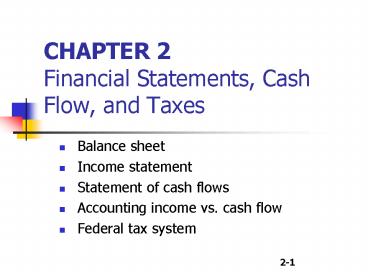CHAPTER 2 Financial Statements, Cash Flow, and Taxes PowerPoint PPT Presentation
1 / 18
Title: CHAPTER 2 Financial Statements, Cash Flow, and Taxes
1
CHAPTER 2Financial Statements, Cash Flow, and
Taxes
- Balance sheet
- Income statement
- Statement of cash flows
- Accounting income vs. cash flow
- Federal tax system
2
Annual Report and Financial
Statements
- Information contained in the annual report is
useful to investors in two major respects - Analysis of past performance, and
- Form expectations about future performance
3
The Annual Report
- Balance sheet provides a snapshot of a firms
financial position at one point in time. - Income statement summarizes a firms revenues
and expenses over a given period of time. - Statement of retained earnings shows how much
of the firms earnings were retained, rather than
paid out as dividends. - Statement of cash flows reports the impact of a
firms activities on cash flows over a given
period of time.
4
Balance Sheet
- Balance Sheet indicates the firms financial
position at a specific point in time. - Left-hand side Assets
- Listed in order of liquidity
- Right-hand side Liabilities and Equity
- Listed in order in which they must be paid
5
Balance Sheet Assets
- Cash
- A/R
- Inventories
- Total CA
- Gross FA
- Less Dep.
- Net FA
- Total Assets
6
Balance sheet Liabilities and Equity
- Accts payable
- Notes payable
- Accruals
- Total CL
- Long-term debt
- Common stock
- Retained earnings
- Total Equity
- Total L E
7
Income Statement
- Income statement shows the financial performance
of the firm during a period of time. - It is a summary of firms revenues and expenses
over an accounting period.
8
Income statement
- Sales
- COGS
- Other expenses
- EBITDA
- Depr. Amort.
- EBIT
- Interest Exp.
- EBT
- Taxes
- Net income
2002 6,034,000 5,528,000
519,988 (13,988) 116,960 (130,948)
136,012 (266,960) (106,784) (160,176)
2001 3,432,000 2,864,000 358,672 209,328
18,900 190,428 43,828 146,600 58,640
87,960
9
Statement of Retained Earnings (2002)
203,768 (160,176) (11,000) 32,592
- Balance of retained
- earnings, 12/31/01
- Add Net income, 2002
- Less Dividends paid
- Balance of retained
- earnings, 12/31/02
10
Statement of Cash Flows
- A statement reporting the impact of a firms
operating, investing, and financing activities on
cash flows over an accounting period. - It summarizes the changes in the firms cash
position during an accounting period. - Operating Activities
- Net Income
- Depreciation and amortization
- Decrease in current assets
- Increase in current liabilities
- - Increase in current assets
- - Decrease in current liabilities
11
Statement of Cash Flows
- Investing Activities
- Inflows
- Sales of fixed assets
- Sale of debt or equity securities of other
entities - Collecting on loans (principal)
- Outflows
- Acquisition of fixed assets
- Purchase of debt or equity securities of other
- entities
- Lending money (principal)
- Financing Activities
- Inflows
- Proceeds from borrowing
- Proceeds from issuing equity securities
- Outflows
- Repaying of debt (principal)
- Repurchase of firms own shares
- Payment of dividends
12
Statement of Cash Flows (2002)
- OPERATING ACTIVITIES
- Net income
- Add (Sources of cash)
- Depreciation
- Increase in A/P
- Increase in accruals
- Subtract (Uses of cash)
- Increase in A/R
- Increase in inventories
- Net cash provided by ops.
(160,176) 116,960 378,560 353,600 (280,960) (57
2,160) (164,176)
13
Statement of Cash Flows (2002)
(711,950) 436,808 400,000 (11,000) 825,808 (
50,318) 57,600 7,282
- L-T INVESTING ACTIVITIES
- Investment in fixed assets
- FINANCING ACTIVITIES
- Increase in notes payable
- Increase in long-term debt
- Payment of cash dividend
- Net cash from financing
- NET CHANGE IN CASH
- Plus Cash at beginning of year
- Cash at end of year
14
Net Cash Flow
- Net Cash Flow (NCF) is actual net cash generated
by the firm during a specified period. - NCF differs from Net Income or the Accounting
Profit. - Accounting Profit is calculated on accrual
basis (revenues earned and expenses incurred)
rather than on cash basis (revenues received
and expenses paid).
15
Net cash flow
- NCF02 NI Dep
- (160,176) 116,960
- -43,216
- NCF01 87,960 18,900 106,860
16
Corporate and Personal Taxes
- Both have a progressive structure (the higher the
income, the higher the marginal tax rate). - Corporations
- Rates begin at 15 and rise to 35 for
corporations with income over 10 million. - Also subject to state tax (around 5).
- Individuals
- Rates begin at 10 and rise to 38.6 for
individuals with income over 307,050. - May be subject to state tax.
17
Tax treatment of various uses and sources of funds
- Interest paid tax deductible for corporations
(paid out of pre-tax income), but usually not for
individuals (interest on home loans being the
exception). - Interest earned usually fully taxable (an
exception being interest from a (muni). - Dividends paid paid out of after-tax income.
- Dividends received taxed as ordinary income for
individuals (double taxation). A portion of
dividends received by corporations is tax
excludable, in order to avoid triple taxation.
18
More tax issues
- Tax Loss Carry-Back and Carry-Forward since
corporate incomes can fluctuate widely, the tax
code allows firms to carry losses back to offset
profits in previous years or forward to offset
profits in the future. - Capital gains defined as the profits from the
sale of assets not normally transacted in the
normal course of business, capital gains for
individuals are generally taxed as ordinary
income if held for less than a year, and at the
capital gains rate if held for more than a year.
Corporations face somewhat different rules.

